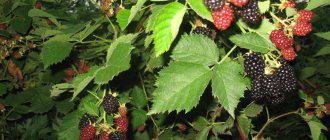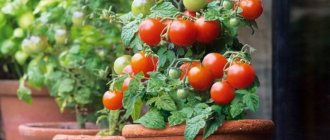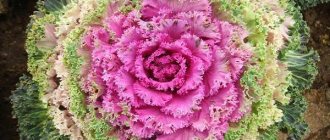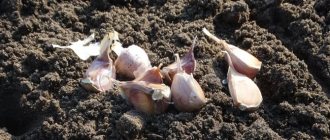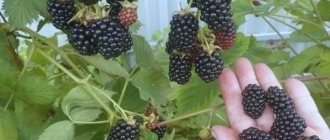Botanical description, characteristics
Blackberry is a climbing shrub of the Rosaceae family with numerous spines. Most cultivated varieties of this plant tolerate frosts down to -25...-30°C. They are also moderately resistant to heat and drought.
In the first year of development, the blackberry stem develops vigorously. Its length can exceed 6 m. The climbing shoot will stretch along the ground. It is completely covered with thorns. Above it rise complex leaves, which consist of 5 leaflets per stem. This plant can take root wherever the stem touches the ground, so in the wild it forms almost impenetrable thickets.
In the second year of development, the stem stops growing in length and acquires a dark brown color. Now side branches are forming on it. Blackberry blossoms begin in late spring and occur on the formed side branches. White or pale pink flowers reach 3 cm in diameter. They are pollinated by insects, and by the end of summer the plant will produce delicious drupes.
Characteristics of berries:
- short stalk;
- cylindrical shape;
- color - dark purple or black;
- weight - about 5 g;
- taste - sweet and sour.
Non-thorny varieties were first developed at the University of Arkansas (USA). These plants bloomed and fruited in the same way as garden raspberries: on the shoots of the first year of development.
Did you know? Bees collect nectar from wild blackberry flowers and make dark honey with an original fruity taste.
Description of thornless blackberry varieties
Blackberries have undergone a number of changes with cultivation. What is characteristic of garden berries is that:
- It has a compact or creeping bush shape with shoots reaching a length of 1.5 to 4 meters, smooth, without thorns.
- A powerful branched root system helps the crop quickly adapt to new conditions.
- Small openwork leaves are located on short petioles.
- The flowers are white or pink and have a diameter of about 2 centimeters.
- The berries, similar in structure to raspberries, have a large white stalk with black or dark red drupes.
Some thornless varieties are resistant to low temperatures, while others require shelter for the winter. Regular climbing blackberries take 2 years to develop. First, when young shoots grow, fruit buds are formed. Then they give berries and then the old fruit ones are cut out. Remontant types of crops without thorns can produce berries on both new and old branches.
Advantages and disadvantages
- The advantages of thornless varieties are:
- higher yield than wild plants: up to 99 c/ha;
- non-traumatic form of berry picking;
- frost resistance;
- high taste qualities of fruits.
- The disadvantages were inherited by cultivated varieties from wild species and have not yet been completely removed:
- the berries ripen unevenly;
- the bush can be attacked by pests (weevils, aphids) and it can be affected by fungi;
- even a slight climate change (rain) sharply reduces the number of insect visits to flowers, which reduces yields.
Varieties
Many cultivated varieties of blackberries have been created in the world for commercial and amateur gardening. One of the largest groups is hybrids of blackberries and raspberries. They were developed under the USDA breeding program. Main varieties: Marion, Chehalem, Olali. They are characterized by original taste and high productivity. Fruiting of most varieties begins in July and lasts until August. Their average yield is about 10 t/ha.
Thornless varieties form the same bush as raspberries. They are very vigorous and require a trellis for support. This group includes: Black Atlas, Chester Thornless, Hull Thornless, Loch Ness, Navajo and many others. Breeders from many countries are working on developments in this direction.
General information
Thornless blackberries are extremely popular. But it cannot be said that previously this berry, which belongs to the Pink family, was not grown in Russia at all. Amateur gardeners were not afraid of thorny branches, as in the case of their relative - raspberries. Of course, we don’t grow blackberries on an industrial scale. Only owners of small farms are interested in this crop, and more and more every year.
Each variety of thornless blackberries contains a large amount of vitamins, microelements and natural sugars.
Blackberries contain natural dietary fiber that provides enormous health benefits:
- indispensable for people suffering from atherosclerosis, neuroses and cardiovascular diseases;
- help cure diseases of the joints, kidneys, intestines and stomach;
- restore lungs after pneumonia and bronchitis;
- strengthens the immune system and cleanses of waste and toxins.
Choosing a variety to grow
When choosing a variety, pay attention to the timing of fruiting, yield and disease resistance. This is important because the bush is grown for its berries, and their yield depends on the capabilities of the variety, the climate, and resistance to disease.
Did you know? Blackberry leaf tea is used in folk medicine as a remedy for diarrhea.
Almost all truces during the American Civil War were declared when dysentery outbreaks occurred to give soldiers time to search for blackberry bushes. Early varieties include bush plants, the harvest of which you can get as early as June. Kara Black has the largest berries in this group. Their weight is about 10 g. Natchez is one of the earliest varieties. Its fruits ripen in mid-June. Atserina is a drought-tolerant blackberry, but not very winter-hardy.
From the category of winter-hardy thornless varieties, we should note the large-fruited Polar, which can withstand frosts down to -30°C. And this can be considered the maximum indicator of winter hardiness for a plant. The varieties indicated in some sources that can withstand frosts down to -40°C have not been registered in the State Register, so it is not possible to confirm the accuracy of this information.
Remontant varieties deserve special attention. They produce a harvest 2 times a year: the first - in early summer, and the second - closer to autumn. The only representative of this group brought to the market is Prime Arc Freedom. It is characterized by large fruits - up to 15 g, resistance to major blackberry diseases and pests.
Characteristics of appearance
The thornless blackberry has the appearance of a picturesque openwork bush, the green leaves of which are divided into three rows by a jagged edge and slightly drooping. The bush blooms in mid-June with white flowers that have a pink-lilac tint, which after a certain period of time turn into small green berries. Many varieties have a fairly long fruiting period - more than a month. The berries also ripen slowly, becoming first red and then purple during ripeness. One bush can display all the color diversity.
The shrub's roots grow in different directions and reach a length of up to 1.5 meters. Thanks to this, the thornless blackberry easily endures a period of drought, despite the fact that its relatives could not cope with such a problem. Traditional varieties with insufficient watering produced less yield. At the same time, the berries lost their sweetness and became less juicy.
Agricultural technology
Have you ever wondered why grow blackberries when you can pick them in the forest? Experienced gardeners will definitely tell you that they do this because the berries of cultivated varieties are much larger. You can install a trellis for them and then the bush will not take up much space, but will produce up to 20 kg of berries. Blackberry farming technology is very simple. To successfully grow a plant, you will need:
- choose the right area for planting;
- plant plants;
- organize watering, fertilizing and pruning the bush;
- prevent diseases and pests in a timely manner.
Blackberries grow as erect, vertical or trailing vines. If space is not an issue, then leave it to grow as is. And if it is important to preserve the appearance of the site or you have limited space, then you can install a decorative lattice or trellis. This will make caring for the bush and harvesting easier.
Video: Growing blackberries
Deadlines
Blackberries are planted in early spring. She tolerates this well, even if there are still spring soil frosts. But some varieties are recommended to be planted later: in mid-spring and even in summer. These are plants intended for the southern regions. You cannot plant them in the fall after the thermometer drops below -2°C. Bushes planted in autumn should be protected from frost. They, like raspberries, are laid on the ground and covered with a layer of mulch.
You might be interested in reading about what blackberries are compatible with on your site.
Site selection, site preparation
The area should be well lit by the sun. Preferred soil: loamy or sandy loam. Acidity level - 5.5–7.0 pH. Blackberries grow well in acidic or neutral soil, but not in alkaline soil. Before planting, make sure the soil is not too dense. Otherwise, dilute it with sand. Dense soil prevents the development of roots, and this is bad for the development of the bush as a whole.
Dense clay soils have very little organic matter - no more than 2%, so such soil must be diluted with organic fertilizers: rotted manure, compost. Mixing soil with straw also provides many benefits:
- air and water circulation improves;
- moderate soil moisture is maintained;
- nutrients are released gradually and delivered to the plant as needed;
- When organic matter decomposes, soil health improves because many beneficial microorganisms appear in it.
Avoid using wood by-products as fertilizers, such as cedar or cedar shavings.
They are not suitable for blackberries. The area should be completely free of weeds immediately before planting to prevent plants from competing for water and nutrients. Do not plant blackberries in soil that has been used in the last two years to grow tomatoes, potatoes, eggplants or peppers as they can transmit Verticillium wilt to the seedling.
Selection of planting material, how to prepare
Most bushes from nurseries come in containers. This will be a small single-trunk flexible shoot. You can plant it out of the pot in a permanent place along with the soil mixture. The seedling should not be broken at the end, it should have a dense root system, as well as a well-defined growth bud. A new shoot will develop from it.
Removing blackberry shoots in autumn
If the bush was pruned in the spring, then in the fall you only need to get rid of the old shoots. This is done due to the fact that garden blackberries bear fruit only on two-year-old stems. That is, you need to get rid of old branches every year, thereby rejuvenating the bush in order to get a good blackberry harvest next year.
Illustration of old and last year's shoots
Attention! Before you begin the actual work of thinning creeping and erect varieties of blackberries, you should first prepare thick mittens or gloves and sharp pruning shears, and put on rubber boots. There are thornless species of shrubs, but if you come across a plant with thorns, then you need to take care to protect your hands and feet. Scratches from a thorny plant take a long time to heal.
Here are step-by-step instructions on how to prune a bush correctly:
- To begin with, remove the fruit-bearing shoots. It is not difficult to distinguish them from annual ones: old stems are brown or brown in color, while new ones are slightly green or light brown. Inflorescences and stalks remain on last year's branches. The cut is made above the bud so that there are no stumps, which will subsequently begin to rot. If the blackberry is remontant, then you need to trim all the stems to the very root.
- Then you need to start thinning out the remaining shoots. Thin, short stems that have not ripened over the summer are removed. If the bush is too thick, it must be thinned out. Only 5 to 8 of the strongest stems are left. In too severe winters, you can leave a few extra lashes: they get rid of the excess next spring.
- First, the shoots located in the central region of the bush are pinched at a level of 2 m from the ground. Then the side stems are shortened, leaving a length of 0.6 m. If the branches are not treated in this way, then picking berries from the bushes will be problematic, especially for those that grow like fans.
- The next stage is removing diseased shoots. Be sure to inspect the bush for pests. If aphids, spider mites or other insects remain on the rods, they will move to healthy parts of the plant. A sick blackberry bush will not survive the winter.
You should know! It is recommended not to leave infected lashes and all removed old parts of the plant on the site. They must be burned or disposed of along with the trash.
Blackberry thinning
Landing algorithm
Most often, seedlings are grown in a greenhouse before purchase, which means that they may be too tender for planting in open ground. For such plants, it is better to plant after the threat of spring frost has passed.
It is also recommended to carry out acclimatization. To do this, the bush is taken outside for a while during the week before planting. Hardened plants are better accepted and develop after planting in a permanent place. For planting you will need: a seedling, organic fertilizer in the amount of 0.5–1 bucket, sand if you need to make the soil looser.
Planting blackberries step by step:
- Dig planting holes at a distance of at least 1 m from each other. The shrub will need such a long distance when it begins to develop.
- Carefully remove the plant from the pot and straighten the roots.
- Prepare the soil mixture: mixing soil, organic fertilizers in equal parts and adding sand up to 30%.
- Place the seedling in the hole and fill it with soil around the roots. The plant should be installed at the same depth as it was growing in the pot.
- Make sure that the growth bud is no deeper than 3 cm from the soil surface.
- Compact the soil at the roots.
- Water the bush thoroughly.
Video: Planting blackberries
Seasonal care rules
An experienced gardener knows exactly when to water the bushes. It depends on how quickly the soil dries out. During drought, blackberries experience stress, but too much moisture will also be harmful. The plant does not have very deep roots, so water as soon as the soil is dry.
Did you know? Wilted leaves do not always mean that the bush is thirsty. In hot weather, they wilt because they evaporate water faster than the roots can supply them with moisture.
Water your blackberries early in the morning or late in the evening.
At noon, the soil will lose a lot of moisture due to evaporation. When watering, do not wet the leaves. This will provide a good environment for the development of fungi and mold. Water the soil around the bush and do not pour on the plant itself.
Tap water contains chlorine.
If you constantly water with such water, the plants will suffer from its excess. It would be nice if, before the water gets to the blackberries, you prepare a container in which it will settle before watering.
Since weeds compete with plants for nutrients and water, they must be removed after each watering . You can simplify the task by placing a layer of mulch in the root zone. This may be straw or other material. The thickness of the layer is up to 5 cm. It will prevent the growth of weeds, soil compaction and rapid evaporation of moisture.
You can also read about proper spring care for blackberries.
In the spring, when the bushes begin to grow, they need to be fertilized. Mixtures with a balanced amount of nitrogen, phosphorus and potassium are suitable for this. The application rate is 25 kg per 30 linear meters of row. You can dissolve them in water and water the bush, or apply fertilizer in a small furrow around the perimeter of the bush, and then fill it with water. When it is absorbed, you need to level the furrow with the ground.
Pruning and shaping the bush
In early spring, shoots are pruned: the tops are cut off, which stimulates branching. New side shoots provide new places for flower buds to form and increase the yield of berries. Carry out work with sterile instruments. To do this, wipe it with alcohol or an aqueous solution of bleach. If the shoot is shorter than 60 cm, simply cut off the top 3 cm.
Always remove in the spring any diseased shoots that have dried out or been damaged by rodents or wind over the winter. In blackberries, only shoots of the third year of development bear fruit, so in the summer the branches that bear fruit must be cut off. This stimulates the plant to create new ones.
Installation diagram of a trellis made of poles and wire
To install the trellis you will need wooden or metal support posts, as well as wire and eye screws. It is not necessary to paint the wood, but painting will extend the life of the trellis. The support pillars are dug into the ground to a depth of 0.5 m, and then wire is pulled over them. The bottom row is at a height of 0.4 m. It is secured with screws. The shoots are tied with soft strips of fabric so as not to squeeze them.
Use wire with a diameter of 2 mm or thicker. A thinner one will sag and the trellis will look sloppy.
Harvesting and storage
Blackberries are resistant to heat and frost, so they grow almost anywhere. The time for picking berries depends on the variety and climate. The harvest is mainly harvested in July. But in more northern regions it may be August. Remontant varieties bear fruit twice a year: in June and then at the end of August or beginning of September.
The berries are picked manually. Their maturity is determined by color. At the stage of technical maturity, the fruits are red, and at the stage of full ripening they are black or dark purple. Don't pick berries after it rains. They must be dry before harvesting. Ripening does not occur simultaneously, so the berries are collected over several weeks.
Picked berries can be stored for only a few days, so you need to either eat them or freeze them in the freezer. You can also make juice, drinks, jam or other preparations for the winter from them.
Preparing for winter, how to cover
For winter hardiness zones below fifth, you will need to cover the bushes for the winter. Since fruiting will occur on the shoots of the previous season, it is important not to allow the fruit buds to freeze during the alternation of frost and thaw.
Pay attention to the information about when you can remove winter cover from blackberries.
Protecting blackberries in winter is very simple. Remove the branches from the supports and place them on the ground. Cover with a layer of mulch. In early spring, before new growth emerges, lift them and attach them to a trellis. Varieties with vertical, erect shoots are more resistant to frost, but they also need protection from cold winds, so experienced gardeners recommend covering all varieties of blackberries for the winter.
Cumanica and dewberry: how to distinguish?
All varieties of blackberries are classified into 2 large groups based on the characteristics of branch growth and crown shape - erect and creeping. Powerful fruit crops with vertical shoots up to 3 m, which do not reproduce at the tops - these are brambles. Among them are many winter-hardy representatives with thorns.
Dewdrops have elongated creeping branches with fruiting branches. Blackberry varieties without thorns have been bred from this group. The dewberries bear fruit early, the fruits are large and sweet, superior in taste to upright varieties of blackberries. Their winter hardiness is lower, but when crossed with raspberries, farmers managed to obtain more hardy and frost-resistant specimens - the Texas variety, the beloved Izobilnaya, Lucrencia.
Comparison of bramble and dewberry
The intermediate link between these groups is given to semi-creeping varieties of blackberries with drooping tops. In the first 2 years the shoots are close to creeping, later they approach erect.
Reproduction methods
Blackberries are easy to propagate. It reproduces in several ways:
- cuttings;
- rooting the trunk;
- young shoots.
Regardless of the method used, the result will be an exact copy of the mother plant.
If you need to get a lot of bushes, it is best to use cuttings. A juicy and hard branch with a length of 15 to 20 cm is suitable for this. It is placed in a damp mixture of peat and sand to a depth of 5 cm. You can soak the end of the cutting in growth hormone before planting, but this is not necessary. Within 3-4 weeks its roots will begin to develop. Did you know? Blackberry juice is an anti-inflammatory and is recommended for those who suffer from inflamed joints (arthritis). It is recommended to use blackberry decoction lotions to relieve inflammation.
You can separate the root shoot from the main plant and plant it separately.
Such cuttings are dug up in the fall. They should have a fairly developed root system. Until spring planting, they are stored in the refrigerator at a temperature no higher than +4°C. After cold hardening, they are planted in a mixture of sand and peat, just like cuttings. Place the pot with the planted plants in a shaded place until shoots appear. Rooted seedlings are planted in the garden.
Blackberries can take root anywhere on a branch if it comes into contact with the ground. To do this, the branch is bent to the soil and secured with a bracket. Then, after rooting, they are separated from the mother plant and transplanted to a permanent place.
Video: How to propagate blackberries
Caring for thornless blackberries in spring, summer and autumn
To get a good harvest, thornless blackberries need care throughout the growing season.
Principles of growing thornless blackberries
All thornless blackberries, regardless of the growth of the bush, need to be tied to a support. It is optimal to install trellises made of posts and wire. To increase productivity, fertilize, form a bush, loosen and mulch the soil. In the fall, be sure to add superphosphate and ash to the soil. In the spring, feed the bushes with compost and ammonium nitrate.
Diseases and pests
Healthy plants can always cope with a small number of insects or diseases on their own. But none of them is 100% protected from them, so it is necessary to pay attention not only to treatment, but also to disease prevention.
We suggest you pay attention to what the main diseases and pests of blackberries are.
Fungal diseases weaken the bushes and cause the loss of part of the harvest.
They appear as spots or coating on the leaves. Neighborhood with other Rosaceae is an additional factor contributing to infection, since they have common pests.
Fungi are spread by wind, water and through the tools you use to process plants. Main fungal diseases:
- Purple spot - appears as purple spots on shoots and leaves. In affected areas, the stems crack and may dry out. They also become more vulnerable to the effects of frost in winter. For treatment, the plant is sprayed with Fundazol or Topsin M.
- White spot - has symptoms similar to purple. Fungal spores appear as white spots on leaves. As they grow larger, leaves fall off and branches may die.
- Brown spot - manifests itself in large spots that darken, dry inside and at this point holes form in the leaf plate.
- Anthracnose - these are lilac spots on the leaves and shoots. As a result of exposure to the fungus, thickenings appear on the shoots, and the clusters of berries wither and fall off. Infected parts of the bush are removed, and the remaining parts are treated with fungicides.
- Gray rot - the cause of rotting of berries and drying out of shoots. In this case, the fruits fall off, and fungal spores continue to infect the branches with dark spots. For treatment, spraying with Bordeaux mixture (1%) is used.
To eliminate all types of spots and fungal diseases, spraying with copper-based fungicides is used.
This can be Bordeaux mixture (1%) or copper sulfate solution (0.5%). The procedure is repeated after 10 days. For prophylaxis, at the beginning of the season, before the buds open, they are treated with Trichodermin. Important! It is forbidden to spray plants during the flowering period. This will kill pollinating insects.
Viral diseases are transmitted by insects, so prevention of pests is important. Viral or bacterial diseases cannot be cured. Affected plants are usually burned. Among the main viral pathologies: mosaic, ring spot, leaf curl. For prevention, bushes are treated with “Pentafage” 3 times during the growing season.
There are quite a few pests that can feast on plant parts. Among them:
- soil pests: mole cricket, cockchafer larvae;
- insects that feed on plant juices: aphids, mites, sawflies;
- insects that damage fruits: weevil, bud moth.
Most insects live on the underside of the leaf blade. If the plant is very thickened or weeds grow around it, then this will become an excellent environment for the development and reproduction of insects. That is why it is advisable to remove weeds in a timely manner and avoid thickening and poor ventilation of the bush. When pests are detected, insecticides are used.
Features of growing in the Moscow region
The Moscow region belongs to the 4th winter hardiness zone with winter temperatures down to -35°C. For blackberry bushes, these are too low temperatures. You can grow berries if you plant frost-resistant varieties.
The thornless variety Doyle tolerates low temperatures well and is suitable for growing in the Moscow region. Another suitable variety is Illini Hardy. It is considered the most winter-hardy of all. The following 2 varieties also show good resistance to frost, although they are intended for zone 5 - these are Prime Jim and Prime Yang. For successful fruiting, they must be covered with mulch for the winter.
With proper care, blackberries have a long lifespan and fruiting life. Its bushes can bear fruit regularly and are easy to care for. If you have free space, you should consider planting these wonderful shrubs with healthy fruits in your dacha.
When to prune blackberries in the fall
Pruning blackberries in the fall is the most important step in preparing its bushes for winter shelter. It is better to perform autumn pruning in the second half of September, when the harvest is completely harvested. Shoots that bore fruit last season, unreliable shoots and extra branches are cut out.
Shoots left for fruiting for the next season should be trimmed a little to stimulate future side shoots. Cut the wood at the root, without leaving stumps, which can become a source of putrefactive flora and a wintering site for harmful insects.
Proper pruning of all varieties of blackberries for the winter is the most important condition for a future rich harvest of full-fledged fruits.
We grow the stems of creeping varieties of Rosyaniki to their maximum length, or at least 2 meters, if there is a need to shorten them.
